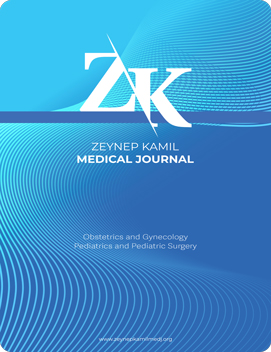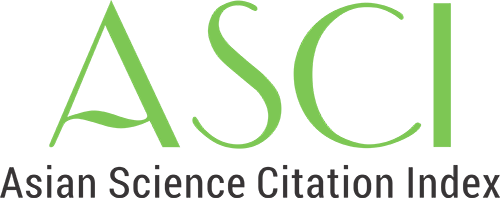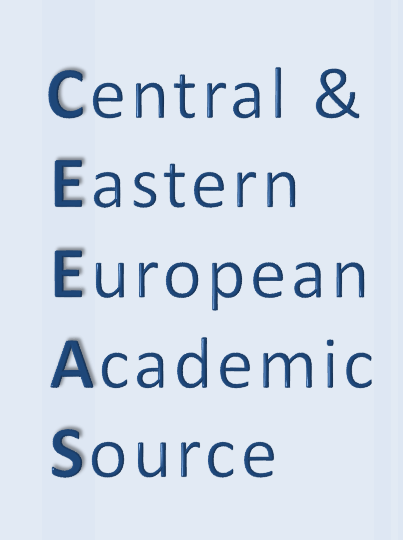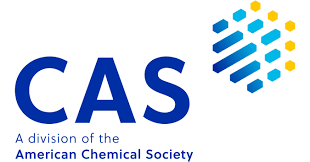Quick Search
Volume: 56 Issue: 1 - 2025
| FRONTMATTERS | |
| 1. | Cover Pages I - II |
| 2. | Editorial Board Pages III - XI |
| ORIGINAL RESEARCH | |
| 3. | Short-term outcomes of mini-sling: A minimally invasive technique in the surgical treatment of female stress urinary incontinence Reyyan Gökçen İşcan, Nurettin Aka, Gültekin Köse, Ertuğrul Can Tüfekçi, Enis Özkaya doi: 10.14744/zkmj.2024.69376 Pages 1 - 5 INTRODUCTION: We aim to present the short-term outcomes of the single-incision mini-sling, an anti-incontinence procedure, as a prospective evaluation by analyzing success rates and complications. METHODS: Between April 2013 and October 2013, in the Department of Obstetrics and Gynecology, Haydarpaşa Numune Training and Research Hospital, thirty patients diagnosed with stress urinary incontinence/mixed urinary incontinence and operated on using the mini-sling technique were included in this prospective cohort study. Following this procedure, this patient group was evaluated in terms of early complications, quality of life, and symptoms. Demographic characteristics, examination findings, frequency of pad use, and perioperative data were recorded. Objective success was evaluated with the cough stress test. Patient Global Impression of Improvement (PGI-I), Urinary Distress Inventory (UDI-6), and Incontinence Impact Questionnaire (IIQ-7) were used to assess subjective success and patient satisfaction. RESULTS: The mean age of the patients was 49.73±6.90 years, and the mean parity was 3.37±1.61. Patients diagnosed with MUI comprised 46.7% (n=14), while 53.3% (n=16) had SUI. The mean operation time was 15.97±5.55 minutes. No perioperative complications were encountered in any of the patients. The subjective success rate was 90%, and the objective success rate was 80% in the 1st and 3rd postoperative months. Significant improvement was observed in the IIQ-7 and UDI-6 questionnaires compared to the preoperative period. During the early postoperative period, vaginal mesh exposure was detected in 10% (n=3) of the patients, UTI in 6.7% (n=2), and leg pain in 16.7% (n=5). De novo urgency was observed in one patient at the postoperative third month, resolving with anticholinergic treatment. DISCUSSION AND CONCLUSION: The mini-sling procedure has several advantages, including ease of learning and performance with a single incision and local anesthesia in a much shorter time, reduced hospital stay, and similar success rates to standard midurethral slings. Randomized controlled studies with long-term results are needed to prove these advantages. |
| 4. | Prenatal diagnosis and associated anomalies of congenital hand malformations Gürcan Türkyılmaz, Zafer Bütün, Onur Karaaslan doi: 10.14744/zkmj.2024.88557 Pages 6 - 12 INTRODUCTION: Congenital hand malformations (CHM) are prevalent congenital anomalies in the prenatal period. We aimed to assess the prenatal features of CHM, associated genetic syndromes, and postnatal prognosis. METHODS: Ultrasound findings, associated anomalies, genetic results, and postnatal course were evaluated in ten cases with CHM in two centers over three years. RESULTS: The mean gestational age at diagnosis was 22.8±2.7 weeks. CHM was isolated in four cases and accompanied by associated anomalies in six fetuses. It was bilateral in six cases. Polydactyly was the most common type of hand malformation. Termination of pregnancy was performed in four fetuses. There was no genetic etiology in isolated cases, and the postnatal course was favorable. Hand malformations with associated anomalies and a genetic syndrome carried a high risk, and the prognosis was poor. DISCUSSION AND CONCLUSION: Prenatal diagnosis of CHM should prompt a detailed anatomical scan and a comprehensive genetic work-up. In isolated cases, the likelihood of a genetic cause is relatively low. In fetuses with multiple congenital anomalies, genetic etiology is common, and the prognosis is poor. |
| 5. | Preoperative inflammatory markers in the prediction of adnexal torsion Mehmet Güçlü, Ismail Bağlar, Esra Keles, Aslıhan Güler doi: 10.14744/zkmj.2024.35556 Pages 13 - 17 INTRODUCTION: To investigate the role of preoperative inflammatory markers in the diagnosis of adnexal torsion (AT). METHODS: A retrospective case-control study was carried out, comparing 110 patients who had undergone surgery for AT with a control group of 102 patients. Demographic characteristics and preoperative hematological parameters were compared between those with and without adnexal torsion. RESULTS: Patients diagnosed with AT had significantly lower age, gravidity, and parity compared to the control group. The AT group had elevated levels of WBC, neutrophils, platelets, and NLR, and lower levels of MPV. Multivariate analysis revealed that NLR, WBC, and MPV were independently predictive of AT. The NLR cut-off value was determined to be 2.64. Based on this value, the sensitivity, specificity, positive predictive value, and negative predictive value were 84.3%, 78.2%, 78.2%, and 84.3%, respectively. DISCUSSION AND CONCLUSION: This study suggests that preoperative inflammatory markers, particularly NLR, may be valuable tools for improving the early diagnosis of AT. In addition, NLR demonstrated superior diagnostic accuracy over WBC count. |
| 6. | Effects of gynecological cosmetic surgery on sexual function Ufuk Atlıhan, Onur Yavuz, Hüseyin Aytuğ Avşar, Can Ata, Alper İleri, Adnan Budak doi: 10.14744/zkmj.2024.34654 Pages 18 - 22 INTRODUCTION: Gynecological cosmetic surgery is a surgical approach that has become increasingly popular to improve genital appearance or sexual satisfaction. We aimed to evaluate the effects of gynecological cosmetic surgery operations on sexual function. METHODS: In our study, the Female Sexual Function Index (FSFI), Quality of Sexual Experience Scale (QSES), and Body Image Quality of Life (BIQL) scores of 96 patients who underwent gynecological cosmetic surgery in our hospital between January 2019 and 2024 were retrospectively evaluated before surgery and 6 months after surgery. Participants information such as age, duration of marriage, marital status, body mass index (BMI), parity, gravidity, type of birth, education, and employment status were obtained from the hospital database. RESULTS: In the study, the BIQL and FSFI scores of the women were found to be significantly higher in the post-surgery period (p<0.001 and p<0.001, respectively). The QSES score of the women was also found to be significantly higher in the post-surgery period (p<0.001). Additionally, the desire and arousal scores of the women were significantly higher in the post-surgery period (p<0.001 and p<0.001, respectively). Similarly, the lubrication and satisfaction scores were found to be significantly higher in the post-surgery period (p<0.001 and p<0.001, respectively). DISCUSSION AND CONCLUSION: The findings from our study showed that women who underwent gynecological cosmetic surgery experienced significant improvements in their body image, sexual function, and satisfaction. Prospective studies with longer follow-up periods and data evaluation from partners are needed. |
| 7. | The impact of progesterone use on the first trimester combined screening test Zafer Bütün, Gökalp Şenol, Kamuran Suman, Ahu Korkut Orta, Vehbi Yavuz Tokgöz, Melih Velipaşaoğlu, Hüseyin Mete Tanır, Ahmet Başar Tekin doi: 10.14744/zkmj.2024.46504 Pages 23 - 26 INTRODUCTION: This study aimed to investigate the impact of luteal phase progesterone supplementation in in vitro fertilization (IVF) pregnancies on the parameters and results of the first-trimester combined screening test. METHODS: A retrospective study involving 230 pregnant women was conducted, including 91 IVF pregnancies and 139 spontaneously conceived pregnancies. The analysis focused on maternal age, levels of pregnancy-associated plasma protein-A (PAPP-A), uterine vascular resistance, and outcomes from the first-trimester combined screening test. RESULTS: The IVF group had a significantly higher maternal age, averaging 34.5 years (±4.2) compared to 30.1 years (±4.5) in the spontaneously conceived group (p<0.001). PAPP-A levels were lower in the IVF group, with an average of 0.88 MoM (±0.32) compared to 1.05 MoM (±0.20) in the spontaneously conceived group (p<0.01). Uterine vascular resistance, measured via Doppler ultrasound, was significantly higher in IVF pregnancies, averaging 0.63 (±0.15) compared to 0.54 (±0.12) in the spontaneously conceived group (p<0.05). Importantly, there were no significant differences in the overall results of the first-trimester combined screening test, with detection rates for aneuploidies of 85.1% in the IVF group versus 87.3% in the spontaneously conceived group (p=0.45), and false positive rates of 5.2% versus 5.8%, respectively (p=0.68). DISCUSSION AND CONCLUSION: While pregnancies achieved through IVF may exhibit increased uterine vascular resistance (11%) and alterations in PAPP-A levels (17% lower), these variations do not lead to significant differences in the outcomes of first-trimester combined screening tests. The combined screening test remains a reliable tool for risk assessment in both IVF and naturally conceived pregnancies, supporting its continued use in clinical practice. Future studies may explore the long-term implications of these biochemical and hemodynamic changes in IVF pregnancies. |
| 8. | Evaluation of the relationship between fetal sex and primary cesarean section rates Can Ata, Ufuk Atlıhan, Onur Yavuz, Hüseyin Aytuğ Avşar, Tevfik Berk Bildacı, Alper İleri, Adnan Budak doi: 10.14744/zkmj.2024.20053 Pages 27 - 31 INTRODUCTION: To investigate the existence of a relationship between fetal sex and primary cesarean section (C/S) rates. METHODS: The demographic characteristics, birth records, and medical characteristics of 58,897 patients who gave birth in our hospital between January 2013 and December 2022 were retrospectively evaluated. A total of 14,045 patients who had a C/S during their previous births were excluded from the study. C/S rates and indications were evaluated according to the presence of male and female fetuses. Pregnancy outcomes of pregnant women in adolescent and adult groups were also assessed. RESULTS: The mean birth length and birth weight in the adult group were found to be significantly higher (p<0.001 and p=0.008, respectively). The 1st-minute and 5th-minute APGAR scores of the adult group were significantly higher than those of the adolescent group (p<0.001 and p<0.001, respectively). A significant difference was found in the probability of primary C/S delivery between male and female fetuses in both the adolescent and adult age groups, with a significantly higher C/S rate observed in male fetuses (p<0.001 and p<0.001, respectively). DISCUSSION AND CONCLUSION: C/S rates are becoming a public health problem in developing countries. It should be kept in mind that fetal sex influences pregnancy outcomes and C/S rates. Additionally, the frequency of some maternal, perinatal, and neonatal complications may be higher in adolescent mothers. |
| 9. | Histopathologic subtypes and clinical evaluation of appendiceal neuroendocrine tumor in children: Single center experience Ilkay Tosun, Semih Mirapoğlu, Hande Nur Inceman, Onur Şahin, Ebru Zemheri, Zekeriya Ilçe doi: 10.14744/zkmj.2024.76736 Pages 32 - 36 INTRODUCTION: Appendiceal neuroendocrine tumors (A-NETs) are rare neoplasms that are usually incidentally diagnosed following appendectomy. This study aimed to review our experiences with A-NETs in children. METHODS: This retrospective study analyzed 3800 children who underwent urgent appendectomy for clinical suspicion of appendicitis at our hospital between 2010 and 2023. Of the appendectomy specimens, 14 were diagnosed as A-NET. RESULTS: The study included 14 patients with a mean age of 14.14 years (range 217), consisting of 9 (64.2%) males and 5 (35.7%) females. The mean tumor diameter was 5.5 mm (range 217 mm), and all tumors were located in the distal appendix. Tumor invasion was observed in the submucosa in one case, muscularis propria in seven cases, subserosa in two cases, serosa in one case, and mesoappendix in three cases. In all cases, resection margins were tumor-free. At the last follow-up (mean follow-up 49.7 months), all patients were alive and without evidence of disease. No recurrence or metastasis was observed. The present study identified 11 tumors with the classic insular growth pattern of solid islands, 2 with a tubular pattern, and 1 with a mixed classic and tubular pattern. DISCUSSION AND CONCLUSION: A-NETs generally have a favorable prognosis in pediatric patients. Hemicolectomy is not recommended for patients with completely resected tumors. |
| 10. | Medication adherence in adolescent asthma patients Murat Özer, Selçuk Doğan doi: 10.14744/zkmj.2024.24445 Pages 37 - 43 INTRODUCTION: One of the most important reasons for the lack of asthma control in adolescents is non-adherence to treatment. This study aimed to investigate the level of adherence to treatment and the factors affecting it in adolescent patients with asthma. METHODS: Adolescents diagnosed with asthma for at least three months and prescribed regular controller therapy were included in the study. The Morisky 8-item Medication Adherence Questionnaire (MMAS-8) was used to assess adherence. In cases of non-adherence, the reasons were investigated. The asthma control test (ACT) was used to evaluate asthma control. RESULTS: The study included 312 adolescents with asthma, aged between 10 and 18 years. It was observed that 57.1% of the patients were non-compliant with asthma treatment. The most common reason for non-adherence was conscious non-adherence (60%). The most frequently reported reasons for non-adherence were I forget to take my medication (27%) and I dont take my medication when other people are around because I dont want my disease to be known (25.8%). A strong positive linear relationship was found between ACT and MMAS-8 scores (r=0.72, p<0.001). DISCUSSION AND CONCLUSION: This study showed that more than half of the adolescent asthma patients were non-compliant with asthma treatment. It was determined that adolescents generally exhibited conscious non-compliance, forgot to take their medication, and did not use their medication appropriately because they concealed their illness from others. Understanding the feelings of adolescent patients and addressing their concerns as part of asthma education may help increase compliance rates. |
| 11. | Is it necessary to use antibiotics in infants followed up for transient tachypnea of the newborn? Seçil Erçin, Yeşim Coşkun, Kalender Kayas, Tuğba Gürsoy doi: 10.14744/zkmj.2024.69782 Pages 44 - 49 INTRODUCTION: Transient tachypnea of the newborn (TTN) is a common cause of respiratory distress in neonates. Despite its benign prognosis, initiating empiric antibiotics is one of the main treatment options besides respiratory support. This study aims to evaluate the use of empiric antibiotics for the treatment of TTN. METHODS: This is a retrospective study of 574 neonates with TTN followed up between January 2015 and 2021. Only 17 neonates (3%) received antibiotics, and they constituted group 1. Group 2 consisted of the remaining 557 (97%) infants who did not receive antibiotics. Demographic and clinical data of the neonates were collected and compared statistically. RESULTS: There was a statistically significant difference between the groups for tracheal intubation and NICU stay. In group 1, 8 (47%) infants and in group 2, 17 (3.1%) were intubated (p<0.001). The mean NICU stay was 7 (5.510.5) days in group 1 and 1 (0.82.5) day in group 2 (p<0.001). DISCUSSION AND CONCLUSION: Initiating antibiotic treatment for every neonate diagnosed with TTN is not necessary. Close follow-up of the infant and evidence-based antibiotic use can decrease the adverse effects of antibiotic treatment and the economic burden of this so-called benign disease. |
| CASE REPORT | |
| 12. | Case presentation: Approach to intracranial mass in pregnancy and the importance of differential diagnosis with atypical preeclampsia Nur Durcanoğlu, Narin Ece Çakmak, Gökçe Nur Esen Topal, Adnan Dağçınar, Bahadır Topal doi: 10.14744/zkmj.2024.95815 Pages 50 - 52 During pregnancy, intracranial masses are rare; however, pre-existing asymptomatic masses may become symptomatic due to physiological changes in pregnancy. Patients presenting complaints can mimic serious complications for both the mother and fetus, such as preeclampsia or HELLP syndrome, potentially prolonging the diagnostic and treatment process. In this case presentation, a 20-week pregnant patient presenting with headaches and nausea, initially diagnosed with atypical preeclampsia, later developed bilateral vision loss. Radiological examination revealed a mass in the posterior fossa, leading to surgical planning. The evaluation of intracranial masses encountered during pregnancy underscores the importance of considering the trimester, symptoms, and detailed laboratory investigations. Clinicians should bear in mind rare differential diagnoses when encountering atypical features alongside common pregnancy complications. |
















